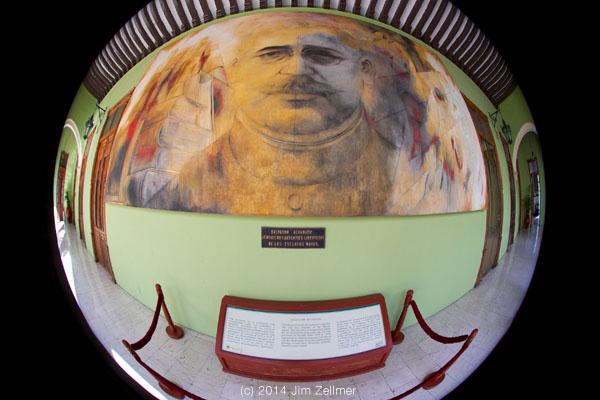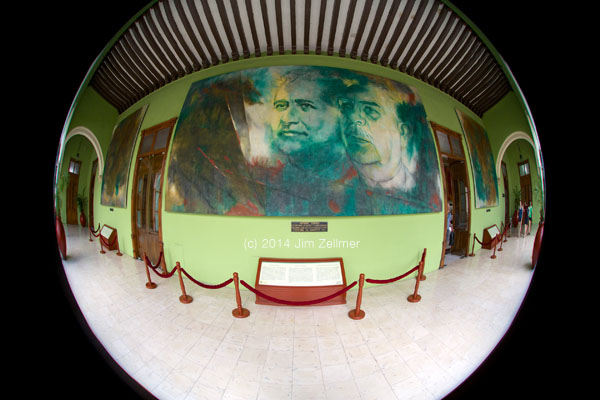Panoramas (tap to pan & zoom)
Still Images (tap for a larger version)
Event website: April 12 – June 26, 2014
Event website: April 12 – June 26, 2014
In the 1989 movie Dead Poet’s Society, Robin Williams, playing the iconoclastic English teacher John Keating, dismisses the notion that you can judge the perfection of a poem mathematically by plotting how artfully it employs meter, rhyme, and metaphor against how important the subject is. Rather than have his students think they could graph the relative merits of, say, a Shakespeare sonnet against a poem by Alan Ginsberg, he has them rip up their textbooks. Data can’t tell us anything about stories, he’s saying, as pages of Understanding Poetry, by Dr. J. Evans Pritchard, Ph.D., fly all over the room.
Businesspeople are often advised to turn their data into stories to make them more persuasive. And that is certainly good advice. But they are given precious few tools to help them do that. It turns out though, John Keating notwithstanding, that graphs can be remarkably useful in demonstrating the mechanics underpinning an effective story. One person who’d given this a lot of thought was novelist Kurt Vonnegut, a real-life literary iconoclast if there ever was one.
Chocolate consumption could hypothetically improve cognitive function not only in individuals but in whole populations. Could there be a correlation between a country’s level of chocolate consumption and its total number of Nobel laureates per capita?
For reasons of health, Gabriel Garcia Marquez, Colombia’s illustrious Nobel Laureate for literature, has declared his retirement from public life. He has terminal cancer and sends this letter of farewell to friends and lovers of literature.
If God, for a second, forgot what I have become and granted me a little bit more of life, I would use it to the best of my ability.
I wouldn’t, possibly, say everything that is in my mind, but I would be more thoughtful l of all I say.
I would give merit to things not for what they are worth, but for what they mean to express.
I would sleep little, I would dream more, because I know that for every minute that we close our eyes, we waste 60 seconds of light.
I would walk while others stop; I would awake while others sleep.
If God would give me a little bit more of life, I would dress in a simple manner, I would place myself in front of the sun, leaving not only my body, but my soul naked at its mercy.
To all men, I would say how mistaken they are when they think that they stop falling in love when they grow old, without knowing that they grow old when they stop falling in love.
I would give wings to children, but I would leave it to them to learn how to fly by themselves.
To old people I would say that death doesn’t arrive when they grow old, but with forgetfulness.
I have learned so much with you all, I have learned that everybody wants to live on top of the mountain, without knowing that true happiness is obtained in the journey taken & the form used to reach the top of the hill.

Two additional panoramas: Staircase Courtyard.
Wikipedia on Fernando Castro Pacheco:
Between 1971 and 1979 Castro Pacheco completed 27 murals for the governor’s palace in Mérida, Yucatán. These murals depict what some consider the realities of life in the Yucatán after the Spanish conquest as well as images and myths of native Maya tribes indigenous of the Yucatán region. The murals depict scenes of work and torture that the native peoples of the Yucatán endured under Spanish control. The reality of early henequen workers are seen in El henequen. A traditional creation myth of the native tribes is also depicted by Castro Pacheco in his work Hombres de maiz. The murals are oil paintings on large format canvas.
Lonely Planet.
Wikipedia on Merida.




To celebrate our VW Beetle’s 40th birthday we decided to take it home. Having been built in Germany in 1972 she spent most of her life in Britain. 40 years later it seemed a fitting celebration to go back to the factory.
And after it’s happened, there’s no going back. Capitalism’s process of creative destruction then takes over: knowledge can’t be put back in the bottle. Once it is known that it is possible to operate in this better, faster way, it will inexorably become the new normal. Customers will expect nothing less. Except where government regulation or private monopolies preserve the status quo, firms that don’t adjust over time won’t survive.
Becoming Agile will steadily become a requirement just to stay in business. In effect, for most companies, failure to acquire digital agility will be an existential threat and so, establishing digital agility has become in effect a strategic necessity.
How practical is it?
Richard Straub, President of the Drucker Society Europe wrote that “improving the software in small increments seems to work much better than having a mega update in longer cycles. It seems to work better for all stake-holders – customers, employees and the investors.” He also had a few more practical questions worth exploring:
Since then, Google has soared to near the top of the city’s lobbying ranks, placing second only to General Electric in corporate lobbying expenditures in 2012 and fifth place in 2013.
The company gives money to nearly 140 business trade groups, advocacy organizations and think tanks, according to a Post analysis of voluntary disclosures by the company, which, like many corporations, does not reveal the size of its donations. That’s double the number of groups Google funded four years ago.
This summer, Google will move to a new Capitol Hill office, doubling its Washington space to 55,000 square feet — roughly the size of the White House.
Last Sunday, The Times’ Elisabeth Rosenthal had another in her continuing periodic, and generally excellent, examinations of the costs of health care. This article focused on the cost of devices to treat chronic diseases, including Type 1 diabetes.
“Today, the routine care costs of many chronic illnesses eclipse that of acute care because new treatments that keep patients well have become a multibillion-dollar business opportunity for device and drug makers and medical providers,” Rosenthal wrote. The captive audience of people suffering from type 1 diabetes “has spawned lines of high-priced gadgets and disposable accouterments, borrowing business models from technology companies like Apple: Each pump and monitor requires the separate purchase of an array of items that are often brand and model specific. A steady stream of new models and updates often offer dubious improvement: colored pumps; talking, bilingual meters; sensors reporting minute-by-minute sugar readouts.”
Yesterday, I ordered lunch from a gourmet meal-delivery start-up called SpoonRocket – a takeout container of sirloin au poivre and roasted cauliflower that was shuttled to my door in exactly 11 minutes, costing me $8. I then took an UberX car to a meeting across town, paying roughly $10 for a 15-minute ride. On my way, I pulled out my phone to see about getting my broken dryer fixed through Handybook, which provides on-demand repairs in the Bay Area for less than a local handyman would charge.
There are dozens more services like these operating in and around San Francisco – Homejoy for cleaning, BloomThat for flowers, Postmates for courier service, and on and on. Most of them provide cheap, convenient amenities at the tap of a smartphone app. Few of them are profitable on a corporate level. And together, they’ve formed the backbone of a strange urban economy: one in which massive venture-capital injections allow money-losing start-ups to flourish, while providing services that no traditional, unsubsidized business can match. It’s an economy built on patience, and the hope that someday, after the land grab is over and the dust has settled, a better business model will emerge.
It’s hard to know which of today’s new start-ups are unprofitable. But in some cases, losing money is kind of the point. I have no inside information on SpoonRocket’s financials, for example, but I imagine that the company books a loss of a few cents every time I click the order button. (There’s just no way, short of a supply-chain miracle, that my $8 covers the cost of preparing a gourmet lunch, driving it to my house, and paying all the drivers and cooks and engineers and assorted other costs associated with running their business.) But SpoonRocket doesn’t have to make money, because it’s just raised $10 million in venture capital expressly so it can keep its prices low. The metric its investors care about right now is user growth, not profits. And if, indeed, the company is selling meals for less than they cost to make, those investors are willing to fill the gap.
Via Steve Crandall.